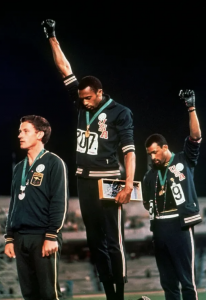Whether you are an elite athlete, or just a Saturday ref at the kids footy, or someone who admires those who step up when it counts, we can all do one thing that speaks of kindness, acknowledgement of past wrongs, of sportsmanship and camaraderie.
One such person was Australian Olympic runner Peter Norman. When you’re at your first Olympic Games it’s easy to be swept up in the moment and focus on it being about you versus the world. But not Peter Norman.

Peter Norman went to the 1968 New Mexico Olympics and ran the fastest race of his life, setting a new Australian record and became Essendon Athletics Club’s first (and to this day only) Olympic medallist by securing silver in the 200m.
He could have focused solely on this fantastic personal achievement, something he’d spent years dreaming about, but he didn’t. He chose that moment to showcase a brave stance in support of human rights and racial equality.
1968 was a big year in the human rights movement – Martin Luther King Jr. and Robert Kennedy had both been assassinated and the Olympic Project for Human Rights (OPHR) was causing headaches for the International Olympic Committee (IOC) as it continued to protest against racial segregation and racism in sport. Athletes had been warned ahead of the games by the IOC that those protesting in support of human rights would risk being thrown out of the games.
Two athletes who were not deterred by these threats where African-American sprinters Tommie Smith and John Carlos, who finished first and third alongside Norman in the 200m.
Their stance was an act that scandalised the Olympics. Smith and Carlos were sent home in disgrace and banned from the Olympics for life. But they were treated as returning heroes by the black community for sacrificing their personal glory for the cause. History, too, has been kind to them.
Yet few know that the man standing in front of both of them, the Australian sprinter Peter Norman who shocked everyone by powering past Carlos and winning the silver medal, played his own, crucial role in sporting and human rights history.
Norman knew that both Smith and Carlos were planning on making some kind of statement on the podium to draw awareness to their fight against racism. He told them he wanted to stand alongside them in solidarity to show his support as he believed in the cause they were fighting for.
So on his left breast Norman wore a small badge that read: “Olympic Project for Human Rights” – an organisation set up a year previously opposed to racism in sport.
But while Smith and Carlos are now feted as human rights pioneers, the badge was enough to effectively end Norman’s career. He returned home to Australia a pariah, suffering unofficial sanction and ridicule as the Black Power salute’s forgotten man. He was never included in the Olympics again, nor welcomed at the Sydney Summer 2000 Games.
1968 was a very different time to what we live in now. It was a time were standing up for racial equality could put a target on your back; something that was evident from the assassinations of King and Kennedy earlier that year. Despite the known risks, three brave men, two Americans and one Australian proudly wore the Olympic Project for Human Rights badge as they stood silently on the podium to showcase their belief in human rights and racial equality. Together Smith, Carlos and Norman showed that there are more important things in life than winning medals. Their actions at the 1968 Olympic Games have become one of the most recognisable moments in modern Olympic history.
Peter Norman ran the fastest race of his life to become part of something that transcended the Olympic Games.
Each of us has an opportunity to stand up and be counted. Vote YES.
DM
